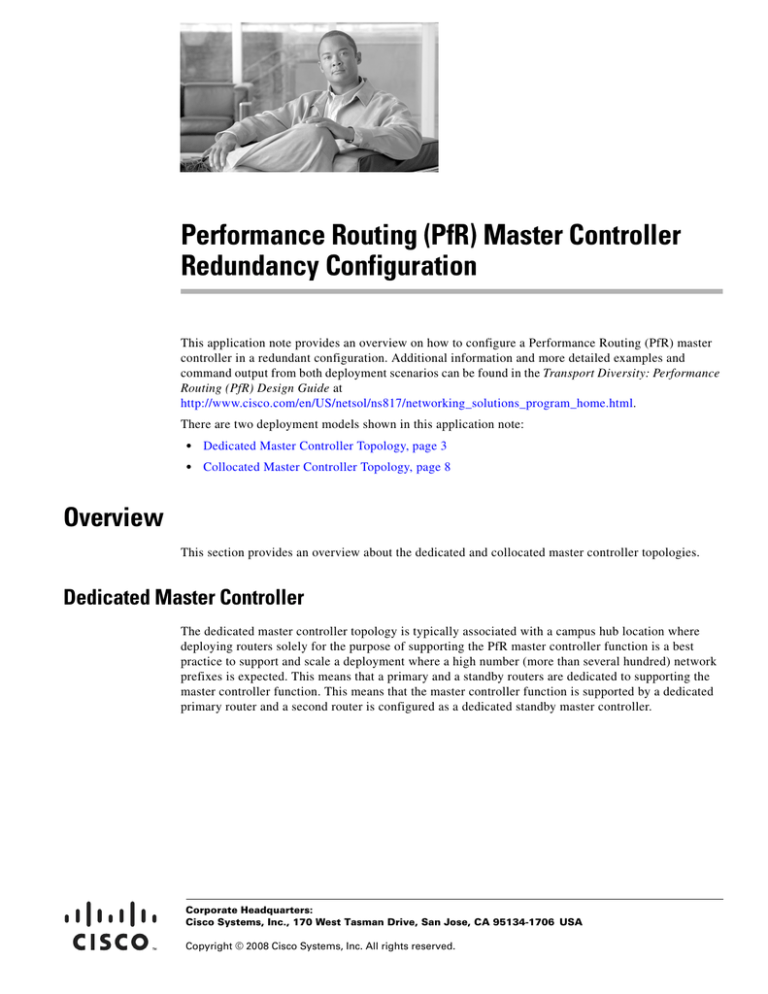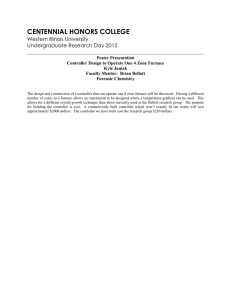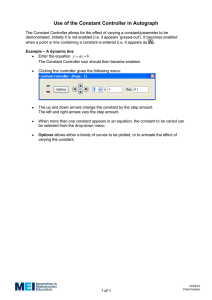
Performance Routing (PfR) Master Controller
Redundancy Configuration
This application note provides an overview on how to configure a Performance Routing (PfR) master
controller in a redundant configuration. Additional information and more detailed examples and
command output from both deployment scenarios can be found in the Transport Diversity: Performance
Routing (PfR) Design Guide at
http://www.cisco.com/en/US/netsol/ns817/networking_solutions_program_home.html.
There are two deployment models shown in this application note:
•
Dedicated Master Controller Topology, page 3
•
Collocated Master Controller Topology, page 8
Overview
This section provides an overview about the dedicated and collocated master controller topologies.
Dedicated Master Controller
The dedicated master controller topology is typically associated with a campus hub location where
deploying routers solely for the purpose of supporting the PfR master controller function is a best
practice to support and scale a deployment where a high number (more than several hundred) network
prefixes is expected. This means that a primary and a standby routers are dedicated to supporting the
master controller function. This means that the master controller function is supported by a dedicated
primary router and a second router is configured as a dedicated standby master controller.
Corporate Headquarters:
Cisco Systems, Inc., 170 West Tasman Drive, San Jose, CA 95134-1706 USA
Copyright © 2008 Cisco Systems, Inc. All rights reserved.
Overview
Collocated Master Controller
The collocated master controller topology is a common deployment in a large branch office environment
where two WAN routers support the branch location. Each WAN router has two or more WAN links
defined as PfR external interfaces. The term collocated refers to the fact that one border router supports
the primary master controller configuration and a second border router is configured as the standby
master controller.
Assumptions
These assumptions are applicable to both deployment models:
•
The reader is familiar with implementing PfR and the focus of this document is to provide an
overview of how to configure a PfR master controller in a standby configuration. This enables WAN
optimization to function in the event the primary master controller fails or is taken out of service for
maintenance.
•
The Collocated Master Controller Topology section consists simply of a topology diagram and
configuration example. The concepts from the Dedicated Master Controller Topology section should
be read and understood before reviewing the Collocated Master Controller Topology section.
More detailed output and validation of these deployments is available in the Transport Diversity:
Performance Routing (PfR) at
http://www.cisco.com/en/US/netsol/ns817/networking_solutions_program_home.html.
PfR requires authentication of border routers and master controllers is accomplished by the use of a
key-chain. A sample configuration is shown below. This required configuration is not shown the
configuration examples for the sake of brevity.
!
key chain NGWAN
key 10
key-string cisco
!
The key-string value of cisco is a lab standard and not recommended for a customer deployment.
Tip
In the event the PfR border router loses contact with the master controller, the border router stops
managing prefixes or applications. In other words, the fail-safe mode of PfR is to remove any routes
injected into the IP routing table or BGP table and to stop policy routing of applications if the master
controller is unavailable.
Performance Routing (PfR) Master Controller Redundancy Configuration
2
OL-15865-01 (EDCS-647718)
Dedicated Master Controller Topology
Dedicated Master Controller Topology
To provide availability of the master controller function, a backup (or standby) master controller can be
implemented using a Hot Standby Router Protocol (HSRP) virtual IP address as the destination IP
address configured in the border routers to identify the master controller. The implementation of PfR is
such that the master controller listens on TCP port 3949 (by default, the port number is configurable)
and the border routers initiate the TCP connection.
If the border routers lose contact with the master controller, the border routers remove PfR controlled
routes and fallback to parent route control. The border routers continuously initiates a connection to the
master controller IP address until a session is established.
To implement a standby master controller, do the following:
Step 1
Configure the PfR master controller configuration identically on both primary and standby.
Step 2
Implement HSRP on the two master controllers.
Step 3
Configure the border routers to use the HSRP virtual IP address to identify the master controller.
Note
The standby master controller functions is in a stateless failover mode. However, standalone
(dedicated) master controllers are not in the data plane switching path, so user traffic is not
disrupted; it is simply not optimized during failover and recovery.
The general guideline is the standby master controller is effectively on-line and operational beginning
with the monitor period following the failure. Therefore, given a 1-minute monitor period, prefixes can
be managed within 2 to 3 minutes following a failure.
More specific implementation details are described in the following section.
Operational Overview
In this sample configuration, the master controller is configured to instruct the border routers to learn
traffic for a 1-minute interval (monitor-period 1) and initiate subsequent monitoring (periodic-interval
0) immediately.
The learned prefixes are maintained by the master controller for the period specified by the expire after
time command value. The number of prefixes learned by the border routers in one interval is specified
by the prefixes command under the learn statement in the master controller configuration. All prefixes
learned are sorted by throughput and the highest (top) ‘n’ throughput prefixes are reported to the master
controller.
PfR Keepalive Disabled
If the PfR keepalive is disabled (no keepalive configured under the oer master section), the state of the
TCP session triggers the failover to the standby master controller. At the failure of the primary master
controller, the standby master controller becomes the active HSRP router and takes over control of the
virtual IP address. The border routers have an open TCP session with the virtual address on TCP port
3949. When the standby master controller receives a TCP packet destined for port 3949 (for which it is
listening, but has no active session) from the border router, it sends a TCP RST (reset) in response. The
Performance Routing (PfR) Master Controller Redundancy Configuration
OL-15865-01 (EDCS-647718)
3
Dedicated Master Controller Topology
border routers log the fact the master controller is down, and immediately attempt to re-establish a TCP
session to the virtual address on port 3949. In the testing environment, the border routers were able to
re-establish communication with the backup master controller within approximately 5 seconds after
receiving the TCP RST.
Network prefixes that are currently under control of an PfR border router (static or BGP) are removed
from the IP routing or BGP table when the master controller is deemed down. The standby master
controller does not have any knowledge of previously learned prefixes, but it begins accumulating the
learned prefixes for every monitor period interval subsequent to the failure of the primary master
controller.
Tip
If testing this failure condition, administratively shutting down the primary master controller
interface does not demonstrate a true failure condition. The Cisco IOS sends a TCP RST for the
active TCP connection on that interface to the border routers. The border routers respond by
tearing down their TCP connection and retry approximately 5 seconds later to establish a
connection to the master controller IP address.
PfR Keepalive Enabled
If PfR keepalives are enabled, these PfR specific keepalives are also used to detect a communication
failure between the master controller and the border routers. The border router can detect a failure of the
master controller after three keepalives are unanswered and deem the master controller down. Once the
master controller is down, either because of the TCP RST message received from the standby master
controller, or the loss of three keepalives, the next course of action by the border router is the same,
attempt to establish a new TCP session with the master controller.
In testing a keepalive value of 1 second was configured and the master controller was declared down 3
seconds after the link was failed between border routers and master controller. The default keepalive
value is 5 seconds. The hold-time (dead interval) is 3 times the configured keepalive value.
The use of PfR keepalive is most applicable to verifying communications with a single master controller.
As the standby master controller sends a TCP RST following assuming control of the virtual IP address,
the use of the PfR keepalive is not required as a recovery mechanism.
Tip
PfR keepalive can be disabled in this configuration. By doing so, it also eliminates the overhead
associated with sending and responding to keepalives and can help in scaling.
Performance Routing (PfR) Master Controller Redundancy Configuration
4
OL-15865-01 (EDCS-647718)
Dedicated Master Controller Topology
Topology
Two border routers are implemented, each with two external (exit) links. A primary and standby master
controller are implemented as shown in Figure 1.
Figure 1
Dedicated Master Controller Deployment Example
192.168.33.0/29
Border Router
inet1-7200-1
.1
Standby
he1-7200-3
Primary
he1-7200-4
Master
Controller(s)
g0/1.30
AS 65503
g0/1.40
AS 65504
g0/1.50
AS 65505
g0/1.60
AS 65506
iBGP Peers
Campus
.3
.2
Border Router
inet1-7200-2
Internal
External
223214
HSRP
10.204.0.2
A single Layer-3 campus switch is implemented in this test deployment. In most customer
implementations, multiple Layer-3 campus switches are deployed for increased availability.
Master Controller Configuration
In the test environment, both primary and standby master controller are configured identically as far as
the oer master portion of the configuration, which is shown as follows:
oer master
no keepalive
!
border 192.168.33.1 key-chain NGWAN
interface GigabitEthernet0/2 internal
interface GigabitEthernet0/1.30 external
interface GigabitEthernet0/1.40 external
!
border 192.168.33.2 key-chain NGWAN
interface GigabitEthernet0/2 internal
interface GigabitEthernet0/1.50 external
interface GigabitEthernet0/1.60 external
!
learn
throughput
delay
periodic-interval 0
monitor-period 1
prefixes 2500
expire after time 4
Performance Routing (PfR) Master Controller Redundancy Configuration
OL-15865-01 (EDCS-647718)
5
Dedicated Master Controller Topology
aggregation-type prefix-length 22
mode route control
mode monitor passive
mode select-exit best
periodic 180
!
Primary Master Controller HSRP interface
The interface used as the target IP address by the border routers for the primary master controller is
shown in the following example. Note that the standby IP address is 10.204.0.2 and this address is used
in the border router configuration rather than the actual interface IP address of the primary master
controller.
interface GigabitEthernet0/2
ip address 10.204.0.4 255.252.0.0
no ip redirects
no ip unreachables
...
standby 0 ip 10.204.0.2
standby 0 timers 3 10
standby 0 priority 110
standby 0 preempt
hold-queue 4096 in
hold-queue 4096 out
!
The configured standby priority of 110 is higher than the default value of 100, making this router the
preferred active HSRP router.
The default value for HSRP timers is 3-second hello and 10-second dead (standby timers 3 10). Given
this is a stateless failover configuration and these master controllers are not in the data path plane (they
are not switching any packets, only managing the master controller database), there is no appreciable
benefit to aggressively tune the HSRP timers to any value lower than the default values. In fact,
increasing the HSRP hello and dead interval times is recommended so that a HSRP failover due to CPU
busy on the primary master controller (a false positive switchover) is avoided. HSRP failover and
recovery within 30 seconds to one minute is sufficient for most deployments.
The hold-queue values of 4096 for both input and output is recommended as all packets on these
dedicated master controller routers is process switched. Buffer tuning is also advised to eliminate buffer
misses and failures.
Standby Master Controller HSRP Interface
The standby master controller HSRP interface uses the default HSRP priority of 100 and has not been
configured to preempt, otherwise, it is identical to the primary master controller configuration.
!
interface GigabitEthernet0/2
ip address 10.204.0.3 255.252.0.0
. . .
standby 0 ip 10.204.0.2
standby 0 timers 3 10
hold-queue 4096 in
hold-queue 4096 out
Performance Routing (PfR) Master Controller Redundancy Configuration
6
OL-15865-01 (EDCS-647718)
Dedicated Master Controller Topology
!
Border Router Configuration
Both border routers are identically configured as shown below:
!
oer border
logging
local GigabitEthernet0/2
master 10.204.0.2 key-chain NGWAN
!
Summary
Implementing a dedicated standby master controller is a simple and effective means of providing
stateless failover for the master controller function for a campus hub location. An additional advantage
to doing so is that PfR keepalives can be disabled since the standby master controller can notify the
border routers indirectly by way of a TCP RST message that the primary master controller has failed and
the standby master controller has taken control of the virtual IP address.
Performance Routing (PfR) Master Controller Redundancy Configuration
OL-15865-01 (EDCS-647718)
7
Collocated Master Controller Topology
Collocated Master Controller Topology
The collocated master controller topology is typically associated with a branch deployment model where
the number of network prefixes or applications being managed are substantially less than at a campus
hub location. Figure 2 is a reference for the accompanying sample configuration below.
Figure 2
Collocated Master Controller Deployment Example
Delay
Generator
Branch
Campus
Standby
Master Controller
he 1-3800-1
border 10.192.0.4
WAE
WAE
Tu2
P-to-P GRE
he 1-7200-3
WAAS CM
P-to-P GRE
IP
IP
Tu3
Tu0
P-to-P GRE
P-to-P GRE
IXIA/Chariot
he 1-7200-4
Tu1
Primary
Master Controller
he 1-3800-2
border 10.192.0.3
Delay
Generator
223226
IXIA/Chariot
Configuration files for both branch routers are shown in the following section. The campus routers could
be similarly configured as the branch routers, or a dedicated master controller topology could be
implemented.
Assumptions
Assume both border routers are configured with HSRP and the virtual IP address is 10.192.0.1. The
primary master controller is the active HSRP router. The standby master controller is the standby HSRP
router.
Because PfR must have at least two external interfaces (exits) to function, the standby master
controller/border router must have at least two exits. This is to meet the minimum of two exit
requirement in the event the primary master controller / border router fails or is taken out of service. A
typical deployment would have both border routers with two exits as shown in the topology diagram.
In the configuration examples, oer-map BRANCH is omitted for brevity.
Performance Routing (PfR) Master Controller Redundancy Configuration
8
OL-15865-01 (EDCS-647718)
Collocated Master Controller Topology
Primary Master Controller and Border Router
The system image file is flash:c3845-adventerprisek9-mz.124-11.T3.bin.
!
hostname he1-3800-2
!
!
oer master
policy-rules BRANCH
logging
!
border 10.192.0.3 key-chain NGWAN
interface GigabitEthernet0/1.1100 internal
interface Tunnel0 external
interface Tunnel1 external
!
border 10.192.0.4 key-chain NGWAN
interface GigabitEthernet0/1 internal
interface Tunnel2 external
interface Tunnel3 external
!
learn
throughput
delay
periodic-interval 0
monitor-period 1
prefixes 2500
aggregation-type prefix-length 29
mode route control
mode monitor passive
mode select-exit best
periodic 180
!
oer border
logging
local GigabitEthernet0/1.1100
master 10.192.0.1 key-chain NGWAN
!
!end
Standby Master Controller and Border Router
The system image file is flash:c3825-adventerprisek9-mz.124-11.T3.
!
hostname he1-3800-1
!
!
oer master
policy-rules BRANCH
no keepalive
logging
!
border 10.192.0.4 key-chain NGWAN
interface GigabitEthernet0/1 internal
interface Tunnel2 external
interface Tunnel3 external
Performance Routing (PfR) Master Controller Redundancy Configuration
OL-15865-01 (EDCS-647718)
9
Collocated Master Controller Topology
!
border 10.192.0.3 key-chain NGWAN
interface Tunnel0 external
interface Tunnel1 external
interface GigabitEthernet0/1.1100 internal
!
learn
throughput
delay
periodic-interval 0
monitor-period 1
prefixes 2500
expire after time 65000
aggregation-type prefix-length 29
mode route control
mode monitor passive
mode select-exit best
periodic 180
!
oer border
logging
local GigabitEthernet0/1
master 10.192.0.1 key-chain NGWAN
!
!
end
Summary
By implementing a primary and standby master controller at branch locations, traffic optimization can
continue to function in the event one of the two branch routers fails or is taken out of service for
maintenance.
Performance Routing (PfR) Master Controller Redundancy Configuration
10
OL-15865-01 (EDCS-647718)






